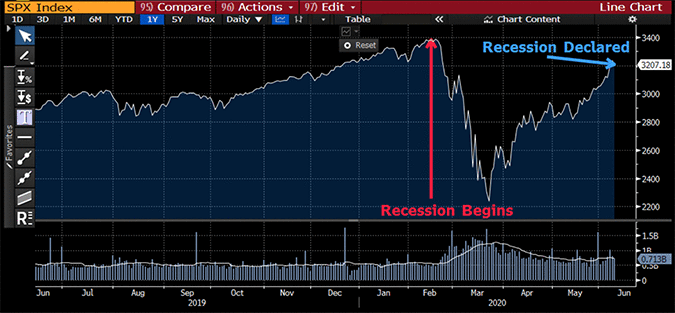CKBlog: The Market
Thursday, June 11, 2020
In Recession
by Steve Haberstroh, Partner
“Cambridge, June 8, 2020 - The Business Cycle Dating Committee of the National Bureau of Economic Research maintains a chronology of the peaks and troughs of U.S. business cycles. The committee has determined that a peak in monthly economic activity occurred in the U.S. economy in February 2020.”
—National Bureau of Economic Research (https://www.nber.org/cycles/june2020.html)
“Cambridge, June 8, 2020 - The Business Cycle Dating Committee of the National Bureau of Economic Research maintains a chronology of the peaks and troughs of U.S. business cycles. The committee has determined that a peak in monthly economic activity occurred in the U.S. economy in February 2020.”
—National Bureau of Economic Research (https://www.nber.org/cycles/june2020.html)
Let’s recap what the talking heads on TV have drilled into your head:
“Hold onto your stocks until we are in recession.”
“If we enter a recession, you will want to lower your exposure to stock.”
“Once in recession, stocks tend to enter bear markets. Bear markets can take years before stocks recover.”
Ok. When in recession, we sell stocks. Simple enough, right? Here’s the problem. We just found out we are in recession—roughly four months after the recession began. So now what?
One Year Chart of the S&P 500 Index

This is why investing is so hard. During the four months the NBER took to crunch their numbers and declare a recession, the S&P 500 index dropped by 34% only to rebound by 44%! On the very day NBER declared the recession, the S&P 500 index turned positive on the year. The NASDAQ hit an all-time high 24 hours later!
So now what? Do we wait until NBER tells us the recession ended ... six months after it ended ... to buy stocks again? Or is that now a signal to sell? Is this really how you should be managing your nest egg? Am I being too sarcastic?
Markets look to the future. Economists look to the past. I wouldn’t recommend a buy/sell program based on NBER declarations about what happened months ago.




